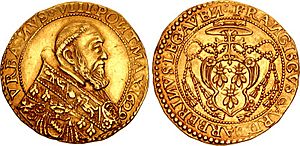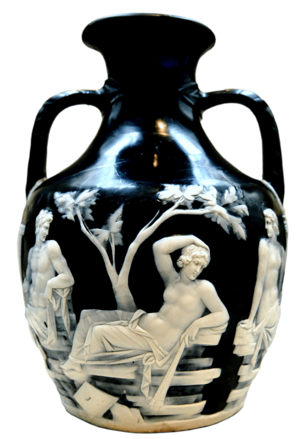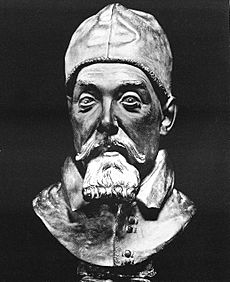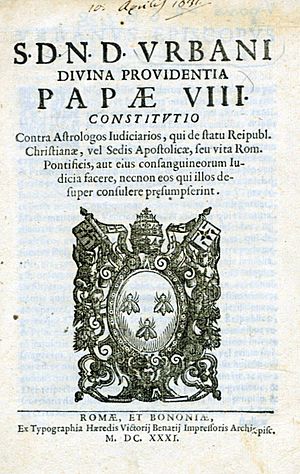Pope Urban VIII facts for kids
Quick facts for kids Pope Urban VIII |
|
|---|---|
| Bishop of Rome | |
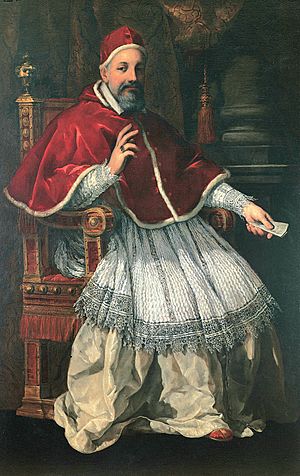
|
|
| Church | Catholic Church |
| Papacy began | 6 August 1623 |
| Papacy ended | 29 July 1644 |
| Predecessor | Gregory XV |
| Successor | Innocent X |
| Orders | |
| Ordination | 24 September 1592 |
| Consecration | 28 October 1604 by Fabio Blondus de Montealto |
| Created Cardinal | 11 September 1606 |
| Personal details | |
| Birth name | Maffeo Vincenzo Barberini |
| Born | 5 April 1568 Barberino Val d'Elsa, Duchy of Florence |
| Died | 29 July 1644 (aged 76) Rome, Lazio, Papal States |
| Parents | Antonio Barberini & Camilla Barbadoro |
| Previous post |
|
| Coat of arms | |
| Other Popes named Urban | |
Pope Urban VIII (born Maffeo Vincenzo Barberini) was the leader of the Catholic Church and the ruler of the Papal States from 1623 until his death in 1644. As pope, he made the papal territory bigger through military action and smart political moves. He was also a big supporter of the arts and helped reform Church missions around the world.
However, the huge debts he created during his time as pope made his successors weaker. They could not keep the Church's strong political and military power in Europe. He also disagreed with the idea that the Earth goes around the Sun (called Copernican heliocentrism). He was involved in the famous case of the scientist Galileo. Urban VIII was the last pope to use the name "Urban".
Contents
Biography
Early life and career
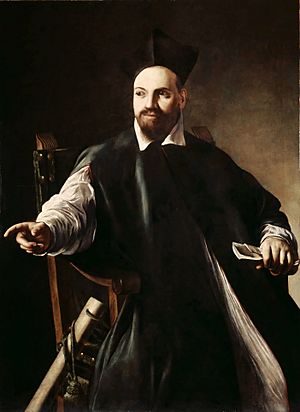
Maffeo Vincenzo Barberini was born in April 1568 in Barberino Val d'Elsa. His father, Antonio Barberini, was a nobleman from Florence. Maffeo's father died when he was only three years old. His mother, Camilla Barbadoro, then took him to Rome. There, his uncle, Francesco Barberini, who was a Church official, took care of him.
When Maffeo was 16, he became his uncle's heir. He studied with the Society of Jesus (also known as the "Jesuits"). In 1589, he earned a law degree from the University of Pisa.
In 1601, Maffeo Barberini became a special representative for Pope Clement VIII to the court of King Henry IV of France. In 1604, the same pope made him the Archbishop of Nazareth. When his uncle died, Maffeo inherited a lot of money. He used it to buy a grand palace in Rome.
Later, Pope Paul V also used Barberini's skills. In 1606, Paul V made him a Cardinal-Priest. He was also appointed as a papal representative for Bologna.
Papacy
| Papal styles of Pope Urban VIII |
|
|---|---|
 |
|
| Reference style | His Holiness |
| Spoken style | Your Holiness |
| Religious style | Holy Father |
| Posthumous style | None |
Becoming Pope
After Pope Gregory XV died, the cardinals met to choose a new pope. This meeting is called a papal conclave. Maffeo Barberini was considered a strong candidate.
On August 6, 1623, Barberini was chosen as the new pope. He took the name Urban VIII. His official crowning had to wait until September 29, 1623, because he was sick after his election.
Main activities
Urban VIII's time as pope lasted 21 years. This period included much of the Thirty Years' War (1618-1648), which was a very busy time. He declared several people saints, including Elizabeth of Portugal and Ignatius of Loyola, who founded the Jesuits.
Even though they were friends early on, Urban VIII called the famous scientist and astronomer Galileo to Rome in 1633. Urban VIII did not agree with Galileo's ideas that the Earth moves around the Sun. He ordered Galileo's second trial after Galileo published a book where Urban's views were presented by a character named "Simplicio."
Urban VIII also greatly helped his family members. He made his brother, Antonio Marcello Barberini, and his nephews, Francesco and Antonio Barberini, cardinals. He also gave his other nephew, Taddeo Barberini, important titles like Prince of Palestrina. Historians say that during his rule, Urban VIII's family gained a lot of wealth.
Urban VIII was a talented writer of Latin poems. Many of his writings, including hymns, have been printed often.
In 1638, Urban VIII issued a special rule called Commissum Nobis. This rule protected the Jesuit missions in South America. It stopped the enslavement of native people living in the Jesuit Reductions. At the same time, he allowed other religious groups to do missionary work in China and Japan.
In 1624, Urban VIII also made a rule against using tobacco in holy places. Breaking this rule could lead to excommunication. This ban was removed by Pope Benedict XIII about 100 years later.
New saints and blessed people
Urban VIII declared five people saints during his time as pope: Stephen Harding (1623), Elizabeth of Portugal and Conrad of Piacenza (1625), Peter Nolasco (1628), and Andrea Corsini (1629). He also declared 68 people "blessed," including the Martyrs of Nagasaki (1627).
New cardinals
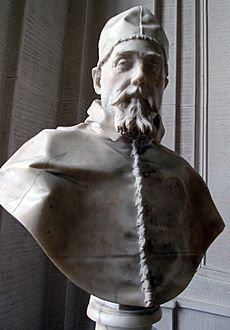
The pope appointed 74 new cardinals during his rule. These included his nephews Francesco and Antonio, his cousin Lorenzo Magalotti, and his own brother Antonio Marcello. He also made Giovanni Battista Pamphili a cardinal. Pamphili later became the next pope, Innocent X.
Rules on private visions
In 1625, Urban VIII issued a rule called Sanctissimus Dominus Noster. This rule told Catholics not to treat deceased people as saints or show them as saints without the Church's official approval. It also required a bishop's approval before any private visions or revelations could be published.
Politics and power
Urban VIII's military actions were not just about spreading Catholicism in Europe. They were also about making sure the Church had its own power in Italy. In 1626, the duchy of Urbino became part of the papal lands. In 1627, he supported Duke Charles of Nevers to rule Mantua. This was against the wishes of the powerful Habsburgs.
He also started the Wars of Castro in 1641 against Odoardo Farnese, the Duke of Parma. Urban VIII removed the Duke from the Church. The city of Castro was destroyed, and its lands became part of the Papal States.
Urban VIII was the last pope to expand the papal territory. He made the town of Castelfranco Emilia stronger. He also asked Vincenzo Maculani to strengthen the Castel Sant'Angelo in Rome. Urban VIII also built a weapons factory in the Vatican and at Tivoli. He also made the harbor of Civitavecchia stronger.
To make cannons and the large bronze canopy (called the baldacchino) in St. Peter's Basilica, huge bronze beams were taken from the Pantheon. This led to a famous saying: quod non fecerunt barbari, fecerunt Barberini, which means "what the barbarians did not do, the Barberini did."
Supporter of the arts
Urban VIII spent a lot of money bringing smart people like Athanasius Kircher to Rome. He also paid for many important works by the sculptor and architect Bernini. Bernini was especially favored by Urban VIII.
Urban VIII asked Bernini to create several portraits of him. He also had Bernini work on the family palace in Rome, the Palazzo Barberini. Bernini also created the Fontana del Tritone in the Piazza Barberini. He also made the baldacchino and the cathedra in St Peter's Basilica. Many of Barberini's family members also had their statues made by Bernini. Urban also rebuilt the Church of Santa Bibiana and the Church of San Sebastiano al Palatino.
The Barberini family also supported painters like Nicolas Poussin and Claude Lorrain. One of the most famous artworks celebrating Urban VIII's rule is the huge painting called Allegory of Divine Providence and Barberini Power. This was painted by Pietro da Cortona on the ceiling of the main hall in the Palazzo Barberini.
Another famous item the Barberini family bought was the 'Barberini vase'. It was supposedly found in the tomb of a Roman Emperor. The vase stayed in the Barberini family's collection for about 150 years. Later, it was sold to the Duke and Duchess of Portland, and it became known as the Portland Vase. This glass vase has been put back together three times after being badly damaged. It is now in the British Museum.
Later life and death
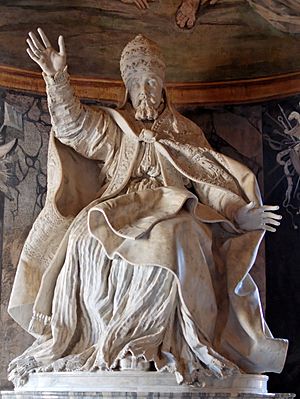
All these military and artistic projects cost a huge amount of money. Urban VIII inherited a debt of 16 million scudi. By 1635, this debt had grown to 28 million. By 1640, it reached 35 million scudi. This meant that over 80% of the Church's yearly income was used just to pay interest on the debt.
Some members of the Spanish group within the Church were very unhappy with Pope Urban VIII. In 1636, they planned to arrest him and replace him with a new pope. But their plan was discovered. The pope quickly returned to Rome and demanded to know who was involved. To stop the plot, the pope ordered all cardinals to leave Rome and go back to their own churches.
Urban VIII died on July 29, 1644. Some say his death was made worse by his sadness over the outcome of the Wars of Castro. Because of the high costs of this war, Urban VIII became very unpopular with the people of Rome.
When he died, a statue of Urban VIII on the Capitoline Hill was quickly destroyed by an angry crowd. Only a quick-thinking priest saved another statue of the late pope from a similar fate.
After his death, the cardinals met again to choose a new pope. They chose Cardinal Giovanni Battista Pamphili, who became Innocent X.
Portrayals in fiction
Urban VIII appears as a character in the Ring of Fire books by Eric Flint and others. In these stories, he is shown in a good way. He is especially important in 1634: The Galileo Affair and other books in the series. He is shown a little differently in Galileo's Dream by Kim Stanley Robinson.
See also
 In Spanish: Urbano VIII para niños
In Spanish: Urbano VIII para niños
- Barberini
- Wars of Castro
- Portrait of Maffeo Barberini
- Cardinals created by Urban VIII
- Pontificio Collegio Urbano de Propaganda Fide
Works
- (in it) Constitutio contra astrologos iudiciarios. Roma: eredi Vittorio Benacci. 1631. https://gutenberg.beic.it/webclient/DeliveryManager?pid=13346228.


